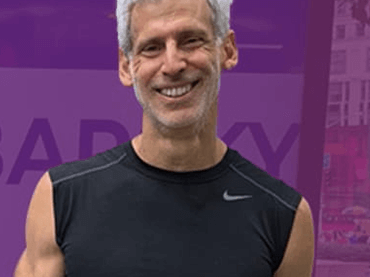The Challenge: Fat Pad Atrophy
Richard Lubarsky remembers the day his foot problems started and made running, his passion, unbearably painful.
Until that day, Richard, a lawyer from Chappaqua, New York, had been falling in love again with running, a sport he did in his twenties but had abandoned for two decades. Now, he was back to training regularly and gearing up for a masters track and field meet in Michigan.
Then, just days before the meet, something changed.
“I woke up and I had pain in my left foot on the inside of my heel,” Richard says.
A local doctor thought his pain stemmed from a stress injury. Not wanting to take any chances, Richard dropped out of the Michigan meet. He hoped that after some proper rest, he could get back to training
But the pain persisted. Suddenly, it was in both heels and in his Achilles tendon. Richard went to a sports podiatrist, who diagnosed him with Achilles tendonitis and plantar fasciitis – an overuse injury that causes heel pain.
“He recommended shock wave treatments. He said I was going to get better, and that I could keep running through the injury,” Richard says. “I believed him because that’s what I wanted to hear.”
But things didn’t get better, so Richard moved on to doctor number three. This doctor diagnosed Richard with fat pad atrophy. Fat pad atrophy is a condition caused by the thinning of the protective fat cushion around the bones of the foot. This can make walking – let alone strenuous activities like running – extremely painful.
“What should I do?” Richard asked when confronted with this diagnosis.
“Find another sport,” the doctor said.
The Path to UPMC: A Novel Treatment
Not content to give up the sport he loved, Richard researched fat pad atrophy and came across UPMC’s Jeffrey Gusenoff, MD, and University of Pittsburgh’s Beth Gusenoff, DPM. Together, the husband and wife team had developed a novel procedure involving fat grafting to the feet to treat patients with pedal fat pad atrophy. Once in clinical trials, foot fat grafting is now offered as an elective procedure.
“I wrote to Dr. Gusenoff. I wanted to see if he knew anyone in New York,” Richard says.
Dr. Jeff Gusenoff couldn’t recommend a doctor in New York, but he invited Richard to Pittsburgh for a consultation.
Richard tucked that information in the back of his mind and continued his search locally.
After seeing two more doctors in New York, both of whom didn’t think he had fat pad atrophy and recommended treatments that were not successful, Richard decided it was finally time to change tactics.
“I think I should see these people in Pittsburgh,” he told his wife.
The Solution: Heel Fat Grafting
Once in Pittsburgh, the doctors confirmed that Richard indeed had fat pad atrophy. That’s when they recommended heel fat grafting. To perform this procedure, fat cells are harvested through liposuction of one’s belly or thighs. These fat cells are then processed in a special way to maintain their integrity. Once processed, the fat cells are injected into the affected area of the foot to increase its cushion and minimize pain on impact.
From the start, Drs. Beth and Jeff Gusenoff were honest with Richard. He was their first distance runner, and they weren’t sure that heel fat grafting would be the answer to all his foot pain problems.
“I’m not just doing this to get back to walking,” he told them. “I’m doing this to get back to running. I will take the risk.”
In the spring of 2017, Richard took the plunge and underwent the heel fat grafting procedure. After returning home, he took it easy for two months. Eventually, he started working out again, first on the elliptical, then on the road. Three months after his heel fat grafting procedure, Richard had returned to running. His first run was short – just half a mile. He waited a week, then upped the distance. In this gradual way, he returned to his love of running.
The Results: Training for the NYC Marathon
A little over a year after the procedure, Richard embarked on a 16-week marathon training program with his eyes on the NYC marathon in November.
Running three days a week instead of four or five, with lots of cross-training in between, he’s making sure to take care of his feet. This means wearing proper footwear, doing foot exercises, and icing his feet after long runs.
While he still has pain from his Achilles tendonitis and plantar fasciitis, the heel fat grafting procedure has helped address the heel pain that had kept him off the pavement for so long.
“I’m not pain-free,” he remarks. “But I’m 50 to 60 percent better. It’s good enough to get back to running.”
“I think Jeff and Beth were really great. And it’s really cool that they figured out how to combine their expertise – her knowledge of the foot, his of fat grafting – and put it together to help people.”
As an avid runner who has found a community because of the sport, Richard doesn’t take for granted this second chance, even if pain is still involved. He is a runner after all, where grit is just another name for the game.
If you, or someone you love, are interested in foot fat grafting for fat pad atrophy or plantar fasciitis, contact us to schedule a consultation: 412-641-3960.

















